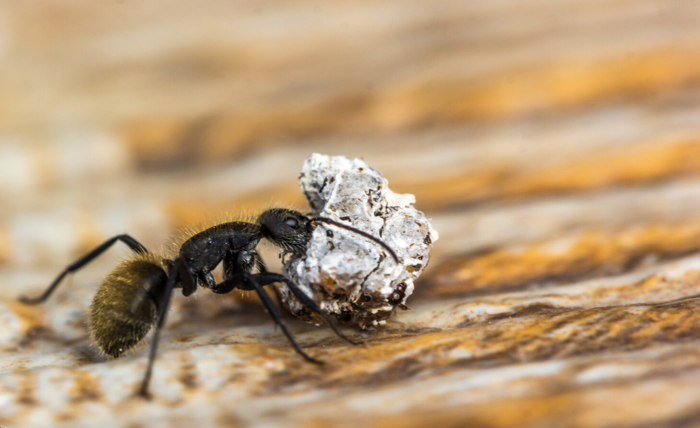
When you spot winged insects around your windows, doors, or foundation, it’s easy to panic — and even easier to misidentify what you’re seeing. At first glance, termites and carpenter ants can look surprisingly similar, especially when they show up during warm weather or after rain. Both species are capable of damaging wooden structures, but the type of damage, the speed at which they cause it, and the long-term consequences vary dramatically. Termites actually eat wood from the inside out, often going unnoticed until the damage is severe. Carpenter ants, on the other hand, don’t consume wood — they excavate it to build galleries for their colonies. Knowing which pest you’re dealing with is the first step toward protecting your home.
Why You Should Call a Pro
While you can look for basic warning signs on your own, telling termites and carpenter ants apart isn’t always simple. Misidentifying them can cost you months of wasted DIY attempts while the real problem keeps spreading inside your walls. That’s why it’s usually safer to bring in a licensed pest control professional who knows what to look for, where to check, and how serious the damage really is.
When it comes to pest control in New Jersey, the challenges are unique. The state’s mix of older homes, humid summers, wet basements, and wooded suburbs creates ideal conditions for both termites and carpenter ants. Local specialists know how to spot early activity in crawl spaces, basements, attic beams, and even brick-face homes that might seem protected. Many NJ companies also offer year-round monitoring plans — especially useful in high-risk counties.
If you live in North Jersey, you can start by searching for local pest control companies in your area or scheduling an inspection with a trusted provider like New Day Pest Control — a team deeply familiar with the specific pest patterns of Bergen, Passaic, Essex, and Hudson Counties.
What Termites Look Like
Termites have a soft, light, almost creamy body color that makes them easy to mistake for pale ants. Unlike carpenter ants, they have no defined waist — their bodies are straight and uniform from head to abdomen. Their wings are another major giveaway: termites have two pairs of wings that are the same size, while ants have uneven wing lengths.
Termites live quietly inside wood and walls, often staying completely hidden until the infestation is advanced. If you see discarded wings near windowsills, baseboards, or entry points — that’s a strong sign of a recent termite swarm.
What Carpenter Ants Look Like
Carpenter ants are generally larger and easier to spot than termites. They come in black, red, or a combination of both colors, and unlike termites, their bodies have a clearly defined narrow waist. Their antennae are bent — another key detail that helps tell them apart.
They also have two pairs of wings, but the front wings are noticeably longer than the back ones. And here’s the most important difference: carpenter ants don’t eat wood — they excavate it, chewing through damp or damaged areas to create smooth tunnels where they live and build their colonies.
Signs of Termite Damage
Recognizing signs of termites in the house early can save you thousands in repairs. One of the first indicators is wood that sounds hollow when tapped — termites consume wood from the inside out, leaving only a thin outer layer. You might also spot mud tubes running along your foundation, walls, or crawl spaces. These tubes protect termites from dry air and predators.
Inside the home, bubbling or peeling paint and drywall can mimic water damage but may signal termite activity underneath. And unlike carpenter ant damage, which looks clean and smooth, termite‑damaged wood appears ragged, broken down, and packed with soil.
DIY vs Professional Inspection
DIY:
You might spot insects, wings, or fine dust.
You may notice damage, but not understand the cause.
Most homeowners never find the nest — or how far the colony has spread.
Professional Inspection:
Moisture scanning to find hidden activity.
Tools to detect colonies inside walls and structural beams.
Accurate species identification.
A targeted treatment plan based on real risk — not guesswork.
Prevention Tips
Fix leaks and moisture issues promptly.
Remove rotten or water‑damaged wood.
Seal cracks, gaps, and entry points around the home.
Keep firewood stacked away from exterior walls.
Clean gutters regularly to prevent moisture buildup.
Trim bushes and branches so they don’t touch the house.
When to Call a Pest Control Expert
You don’t need to wait until the damage is severe. Call a licensed pest control professional if:
You find mud tubes along walls, crawl spaces, or the foundation.
Wooden beams, floors, or trim sound hollow when tapped.
You see winged insects indoors — especially near lights or windows.
DIY sprays or treatments don’t seem to help, or the insects keep returning.
If any of these signs show up, it’s safer to bring in an expert who can inspect, confirm the species, and stop the infestation before it spreads further.
Local Help in North Jersey: New Day Pest Control
Not sure whether you’re dealing with termites or carpenter ants? We offer free inspections in Bergen, Passaic, Essex, and Hudson Counties.
New Day Pest Control isn’t just another extermination service — they’re a local team that understands how New Jersey homes are built, how moisture affects foundations, and how fast termite colonies spread in older neighborhoods with mature trees. They use advanced inspection tools, including moisture meters and wall‑scan technology, to find hidden activity before it becomes visible.
What homeowners love most? They don’t rush treatment. They diagnose first, explain the findings clearly, and then create a customized plan — whether that means bait systems, targeted chemical barriers, or long‑term monitoring. Their technicians are certified, insured, and trained specifically in NJ pest behavior, which means faster identification and smarter prevention.
They also offer seasonal protection plans — a huge advantage in a state where spring swarms and summer humidity create ideal conditions for infestations.
If you want peace of mind, a fast response, and a team that actually knows your area, New Day Pest Control is one of the most trusted names in North Jersey.
Catch It Early, Protect Your Home
: Catch It Early, Protect Your Home https://www.newdaypestcontrol.com/
Termites and carpenter ants don’t announce themselves — they work silently, inside your walls, floors, and foundation. But the sooner you know what you’re dealing with, the faster you can stop the damage. Whether it’s tiny piles of wood dust, discarded wings, or wood that suddenly sounds hollow, every sign matters.
The worst mistake homeowners make is waiting too long. A quick inspection today can save you from structural repairs tomorrow — and calling a specialist doesn’t mean you’re overreacting. It means you’re protecting the place that protects you.
Whether you go DIY first or call a pro right away, remember this: the cost of waiting is always higher than the cost of knowing. And with the right help, you can stop the damage early and keep your home strong, safe, and standing for years to come.




